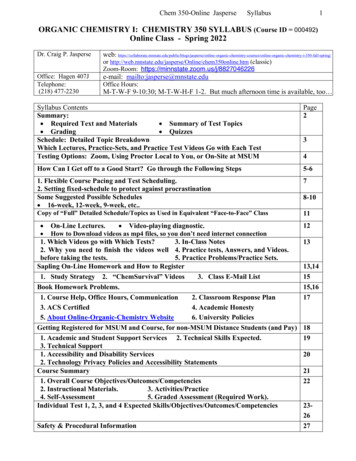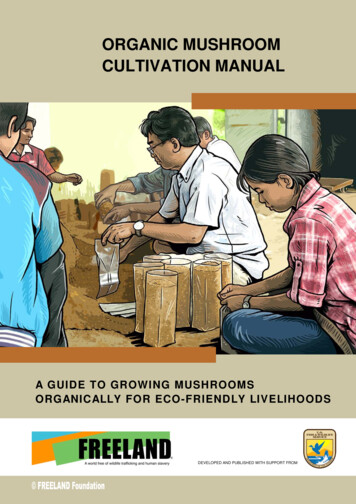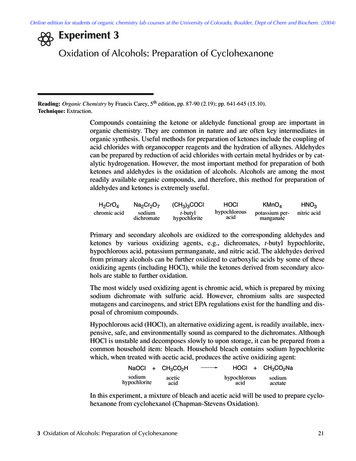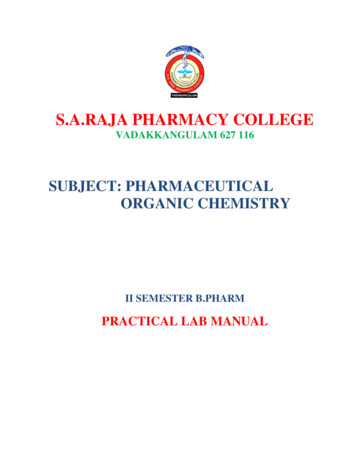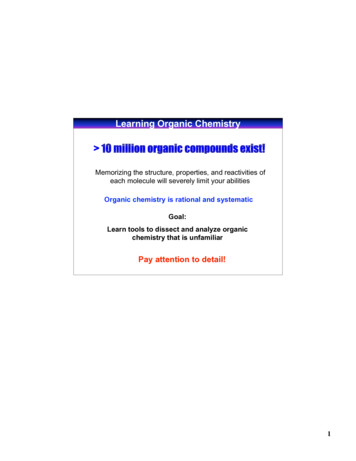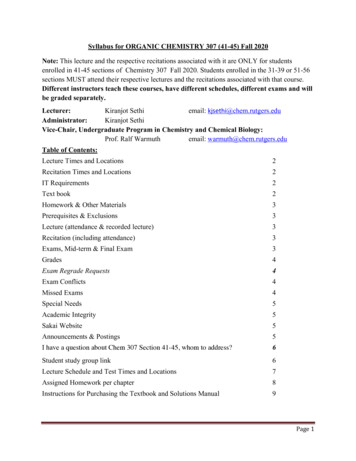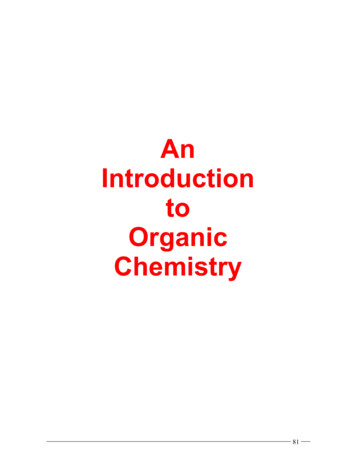
Transcription
AnIntroductiontoOrganicChemistry81
An Introduction to Organic ChemistryOrganic ChemistryOrganic chemistry is the study of compoundscontaining carbon with the exception of simplecompounds e.g. carbonates (CO32-), carbondioxide (CO2) and carbon monoxide (CO).NomenclatureThere are over 6 million known organiccompounds. Nomenclature is therefore veryimportant.Here are some basic guidelines that should helpin the naming of the simple compounds you willcome across during this course. You will getpractice at this in your tutorials.1) Find the longest carbon chain in the molecule.This will give you the base of the name:No of C pent-anehex-anehept-aneoct-anenon-anedec-ane82
An Introduction to Organic Chemistry2) Determine the principle functional group andits position.principalfunctional ylic acidformulaC-CC CC C-OH-CH O C oic acidPosition is indicated, where necessary, bynumbering the carbons in the main chain.Position need not be indicated for alkanes, asthey have no functional group, and aldehydesand acids, as they are terminal functionalgroups. Positioning numbers are flanked bydash signs. Multiple positions for a givenfunctional group are separated by commasand indicated by the prefixes di, tri, tetra,penta, hexa, hepta, octa , nona and deca.3) Ancilliary functional groups are given inalphabetical order, with their position at thebeginning of the name.ancilliaryfunctional 3
An Introduction to Organic omoiodoaminohydroxycyanobenzylphenylEmpirical and Molecular FormulaeQuantitative elemental analysis tells us whatelements make up a compound and in whatproportions.The percentage of each element present in acompound is determined by total combustion. C,H, S and N burn to give CO2, H2O, SO2 and NO2.The quantities of these gases may readily bemeasured and this leads to information that canbe used to calculate the % composition andhence empirical and molecular formulae.84
An Introduction to Organic ChemistryHow is this done? First some definitions:One mole of a substance is 6.02 x 1023 particlesof that substance. This huge value is termedAvogadro’s number. One mole of any substancehas a mass equal to the relative molecular mass(RMM) of that substance in grams.Relative molecular mass is the sum of therelative atomic masses (RAMs) of the constituentelements in the compound.e.g. for ethanol C2H5OHRMM (2 x 12.010 g mol-1) (6 x 1.006 g mol-1) (15.999 g mol-1) 46.057 g mol-10.152 g of an organic compound X containingonly C, H and O produces:0.223 g of CO20.091 g of H2Oupon total combustion. Calculate the empiricalformula of the compound X.Consider the CO2CO2 RMM 12.010 g mol-1 2 x 15.999 g mol-1 44.008 g mol-10.223 g of CO2 0.223 g / 44.008 g mol-1 5.07 x 10-3 mol5.07 x 10-3 mol of CO2 were produced from 5.07 x 10-3 mol of CThe mass of C 5.07 x 10-3 mol x 12.010 g mol-1 0.061 g% C in X 100% x 0.061 g / 0.152 g 40.1%85
An Introduction to Organic ChemistryConsider the H2OH2O RMM 2 x 1.006 g mol-1 15.999 g mol-1 18.011 g mol-10.091 g of H2O 0.091 g / 18.011 g mol-1 5.05 x 10-3 mol5.05 x 10-3 mol of H2O were produced from 1.01 x 10-2 mol of HThe mass of C 1.01 x 10-2 mol x 1.006 g mol-1 0.010 g% C in X 100% x 0.010 g / 0.152 g 6.7%Consider the O% O in X 100% - 40.1% - 6.7% 53.2%Mass % are used to calculate mole % whichyield the empirical formula or simplest ratio of theelements present.Crelative mass %40.1divide by RAM12.010relative mole %3.3divide by smallest1H6.61.0066.62O53.215.9993.31This gives the ratio 1:2:1 and the empiricalformula CH2O. The molecular formula could beany multiple of the empirical formula e.g.C2H4O2, or C3H6O3 since these would all havethe same percentage mass ratios.5.05 x 10-3 mol of C means 5.05 x 10-3 mol of X in 0.152 gRMM of X 0.152 g / 5.05 x 10-3 g mol-1 30.10 g mol-1The molecular formula is also CH2O and X isactually methanal or formaldehyde.86
An Introduction to Organic ifferent arrangements of atoms for a givenmolecular formula are often possible. Suchcompounds are called isomers.Example one: C4H10CH3CH2CH2CH3HHHCHHCHHCCH3CHCH3CH3HCHHHHC HH CHC H HHCHH87
An Introduction to Organic ChemistryExample two: C2H6OCH3CH2OHHCH3OCH3HHHHHHHCOCCCHOHHHOHOBoth exemplify structural isomerism. C4H10 is amolecular formula as it shows constituent atoms.CH3HC2CH2CH3 is a structural formula as itshows constituent atoms AND connectivities.StereoisomerismIt is also possible to arrange the atoms inmolecules with the same structural formulaesuch that they have different spatial orientation.This is known as stereoisomerism.There are two distinct types of stereoisomer:geometric and optical.88
An Introduction to Organic ChemistryGeometric isomerismIt is possible for single C-C bonds to rotatefreely, however, double C C bonds cannot.Thus if the two carbon atoms of a C C bondcarry different groups, it becomes possible toorientate these groups in two ways to creategeometric isomers.HCOOHHCOOHcis-isomerZ(Zusammen - together)HOOCHHCOOHtrans-isomerE ( Entgegen - opposite)Geometric isomers have different physical andchemical properties89
An Introduction to Organic ChemistryOptical isomerismA carbon atom attached to four different groups(substituents) is termed a chiral centre.Two different non-superimposable mirror imagesare possible.These mirror images are called enantiomers.Enantiomers have identical physical properties,except for the direction in which they rotate theplane of plane polarised light.Rotation to right termed dextro or dRotation to left termed laevo or lThey have identical chemical properties excepttowards optically active reagents.90
An Introduction to Organic ChemistryIf a compound contains a chiral centre but doesnot rotate the plane of plane polarised light thenit must be an equal mixture of d- andl-enantiomers. Such a mixture is termed aracemic mixture or a racemate.Stereochemistry is crucially important to thepharmaceutical industry. The drug thalidomide,prescribed to pregnant women as a powerfulsedative from 1956 exists as two enantiomers.One was the powerful sedative. The othercaused human transmutation 91
An Introduction to Organic ChemistryHybridisationThe simplest organic molecule is methane CH4.The ground electronic state of carbon suggests itshould form 2 bonds as there are two unpairedelectrons.How and why does carbon form 4 bonds?Promotion of one of the two 2s electronsincreases energy but the formation of four bondscauses a four-fold decrease.How can the four bonds formed beidentical?92
An Introduction to Organic ChemistryThis mixing of an s orbital and three p orbitals toproduce four hybrid orbitals is called sp3hybridisation.ALL tetrahedral carbon andnitrogen atoms in organic chemistry are sp3hybridised.ALL trigonal carbons such as those found indouble bonds are sp2 hybridised. The unused porbital on each carbon overlaps to form the πpart of the double bond, e.g. ethene.93
An Introduction to Organic ChemistryALL linear carbons such as those found in triplebonds are sp hybridised. The unused p orbitalson each carbon overlap to form the π parts of thetriple bond, e.g. ethyne (acetylene).94
An Introduction to Organic ChemistryHydrocarbonsHydrocarbons are a family of compoundscontaining only hydrogen and carbon. There aretwo main classes:aliphatic and aromaticWithin the aliphatic class there are bothsaturated and unsaturated hydrocarbons.The AlkanesA homologous series of saturated compoundswith general molecular formula CnH2n 2 (where nis an integer).methane CH4, ethane C2H6, propane C3H8, butane C4H10, pentaneC5H12, hexane C6H14, heptane C7H16, octane C8H18, nonane C9H20,decane C10H22, etc.Homologous series: a series of compounds inwhich each successive compound differs fromthe previous one by a CH2 unit.At n 4 it becomes possible to arrange thecarbon skeleton differently i.e. it becomespossible for structural isomers to exist. Theresult is termed branching of the C-C backbone.95
An Introduction to Organic ChemistryHow does this affect a physical property such asthe boiling point?n-pentane2-methylbutane2,2-dimethylpropane36 C28 C9 CAs branching increases, the strength of the vander Waals interactions between moleculesdecreases, resulting in the lowering of boilingpoints.OccurrenceNatural gas - principally methane CH4Petroleum oil - mixture up to ca. n 40Separation of crude oil is achieved by fractionaldistillation. This forms the basis of the petroleumand petrochemical industries.ChemistryRelatively, alkane chemistry is very limited.Their main use is as fuels for combustion oroxidation.Methane domestic gas supplyPropane LPG (liquid propane gas)Butanecamping stove gas96
An Introduction to Organic ChemistryOctanepetrolComplete combustion yields carbon dioxide andwater. Incomplete combustion is dangerous as itproduces carbon monoxide. Always provide agood supply of air to any process in which ahydrocarbon is being burned2C2H6(g) 7O2(g) Æ 4CO2(g) 6H2O(l)2C2H6(g) 5O2(g) Æ 4CO(g) 6H2O(l)Chemically this is more accurately described asoxidation. Both reactions produce energy in theform of heat and are said to be exothermic.HalogenationIn the presence of a halogen and ultraviolet lighta series of reactions take place:Cl2 Æ 2Cl·[I]Cl· CH4 Æ CH3· HCl[P]CH3· Cl2 Æ CH3Cl Cl·[P]Cl· CH3Cl Æ CH2Cl· HCl[P]CH2Cl· Cl2 Æ CH2Cl2 Cl·[P]Cl· CH2Cl2 Æ CHCl2· HCl[P]CHCl2· Cl2 Æ CHCl3 Cl·[P]Cl· CHCl3 Æ CCl3· HCl[P]CCl3· Cl2 Æ CCl4 Cl·[P]Cl· Cl· Æ Cl2[T]CH3· CH3· Æ C2H6[T]97
An Introduction to Organic ChemistryThe first step is homolytic fission of the halogento produce halide radicals. This is termed theintitiation step, [I].Radicals are extremelyreactive species with single unpaired electronsdenoted ·. Radicals react with non-radical andradical species in propagation and terminationsteps, [P] and [T] respectively. The result is anextensive, indiscriminate mixture of halogenatedhydrocarbons that is very expensive to separate.Reactivity: F2 Cl2 Br2 I2Provides an albeit prohibitively expensive routeto useful compounds since polarity (and thuschemical reactivity) has been introduced.CrackingThis is enormously important industrially. Thebonds in longer chain alkanes are cleaved usingheat in a process called pyrolysis. The processproduces smaller more useful hydrocarbonmolecules.98
An Introduction to Organic ChemistryThe AlkenesA homologous series of unsaturated compoundswith general molecular formula CnH2n (n is an integergreater than 1) that contain a double bond.ethene C2H4, propene C3H6, butene C4H8, pentene C5H10, hexeneC6H12, heptene C7H14, octene C8H16, nonene C9H18, decene C10H20,etc.PreparationAlkenes are defined by the presence of a C Cdouble bond. In the laboratory, they can beprepared via the dehydration of alcohols bystrong acid.H (aq)CH3CH2OH Æ CH2 CH2 H2OOne of the most important principles in organicchemistry is the understanding of how reactionshappen at a molecular level. This is termed thereaction mechanism.Mechanisms are represented by "pushingelectrons" between and/or around molecules.The arrows MUST be accurately drawn to showboth the origin and destination of the electrons.99
An Introduction to Organic ChemistrySo what is the mechanism for the dehydration ofethanol?HHHHHO H HHHH HHH O H HHH H HH HH HHA mechanism can NEVER be proven, onlysupported by experimental evidence.The mechanism shown above may be applied tothe dehydration of any alcohol with acid to yieldany alkene.ChemistryAlkenes are much more reactive than alkanes.Most of their chemistry involves addition to theC C double bond.Hydrogenation (Addition)Addition of H2 to C C in the presence of asuitable catalyst e.g. Pd activated charcoal orRaney Ni (treat nickel aluminium alloy with hot NaOH)H2C CH2 H2 Æ H3C-CH3100
An Introduction to Organic Chemistry 82 Organic Chemistry Organic chemistry is the study of compounds containing carbon with the exception of simple compounds e.g. carbonates (CO 3 2-), carbon dioxide (CO 2) and carbon monoxide (CO). Nomenclature There are over 6 million known org


